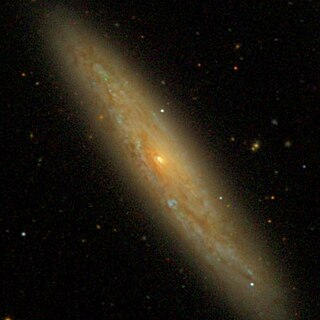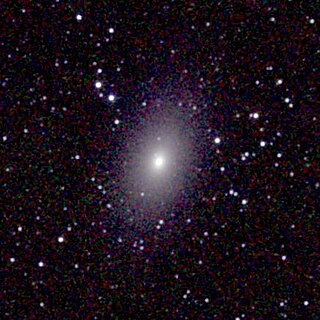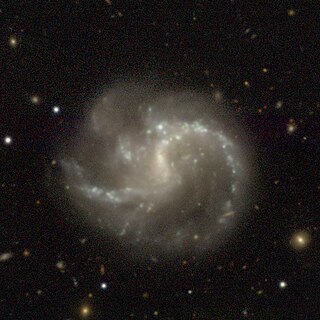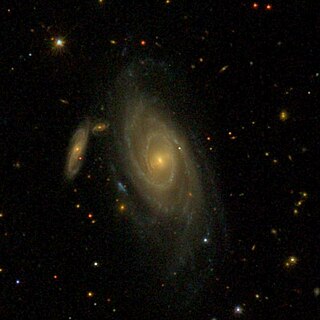
NGC 2 is an intermediate spiral galaxy with the morphological type of Sab, located in the constellation of Pegasus. NGC 2 was discovered by Lawrence Parsons, 4th Earl of Rosse on 20 August 1873."

NGC 3877 is a type Sc spiral galaxy that was discovered by William Herschel on February 5, 1788. It is located below the magnitude 3.7 star Chi Ursae Majoris in Ursa Major.

NGC 6744 is an intermediate spiral galaxy about 30 million light-years away in the constellation Pavo (Peacock). It is considered as a Milky Way mimic in the immediate vicinity, displaying flocculent (fluffy) arms and an elongated core. It also has at least one distorted companion galaxy superficially similar to one of the Magellanic Clouds. It was discovered from Parramatta in Australia by Scottish astronomer James Dunlop on 30 June 1826.

The Atlas of Peculiar Galaxies is a catalog of peculiar galaxies produced by Halton Arp in 1966. A total of 338 galaxies are presented in the atlas, which was originally published in 1966 by the California Institute of Technology. The primary goal of the catalog was to present photographs of examples of the different kinds of peculiar structures found among galaxies.

NGC 4027 is a barred spiral galaxy approximately 83 million light-years away in the constellation Corvus. It is also a peculiar galaxy because one of its spiral arms goes out more than the other. This is probably due to a galactic collision in NGC 4027's past.

NGC 2500 is a barred spiral galaxy in the constellation Lynx which was discovered by William Herschel in 1788. Much like the local group in which our own Milky Way galaxy is situated, NGC 2500 is part of the NGC 2841 group of galaxies which also includes NGC 2541, NGC 2537 and NGC 2552. It has a H II nucleus and exhibits a weak inner ring structure.

NGC 4976 is a peculiar elliptical galaxy in the constellation Centaurus. It was detected with a 5" telescope working at 20x magnification by comet hunter Jack Bennett.

NGC 5101 is a lenticular galaxy in the constellation Hydra. It is separated in the sky from the spiral galaxy NGC 5078 by about 0.5 degrees, and both are believed to be at the same distance from the Earth. This would mean they are approximately 800,000 light-years apart. Both galaxies are believed to be about the size of the Milky Way.

NGC 5112 is a barred spiral galaxy in the constellation Canes Venatici. This galaxy is in close physical proximity to the edge-on dwarf spiral NGC 5107.

NGC 145, also known as Arp 19, is a barred spiral galaxy in Cetus, notable for its three spiral arms.

NGC 3190 is a spiral galaxy with tightly wound arms and lying in the constellation Leo. It was discovered by William Herschel in 1784. NGC 3190 is member of Hickson 44 galaxy group, estimated at around 80 million light years away, and consisting of four galaxies in a tight group - NGC 3193 is fairly featureless, NGC 3187 is a dim but striking spiral galaxy and NGC 3185 has a barred spiral structure with an outer ring. It is also a member of the NGC 3190 Group of galaxies, which is a member of the Leo II Groups, a series of galaxies and galaxy clusters strung out from the right edge of the Virgo Supercluster.

NGC 7 is a barred spiral galaxy located in the Sculptor constellation. It was discovered by English astronomer John Herschel in 1834, who was using an 18.7 inch reflector telescope at the time. Astronomer Steve Gottlieb described the galaxy as faint, albeit large, and edge-on from the perspective of the Milky Way; he also noted how the galaxy could only be observed clearly with peripheral vision, not by looking directly at it.

NGC 14 is an irregular galaxy in the Pegasus constellation. It was included in Halton Arp's Atlas of Peculiar Galaxies, under the section "Galaxies with the appearance of fission," since the irregular appearance of this galaxy causes it to look like it is coming apart. It was discovered on September 18, 1786, by William Herschel.

NGC 19 is a spiral galaxy in the Andromeda constellation. It was discovered by Lewis Swift on 20 September 1885. It is often incorrectly listed as a duplicate of NGC 21.

NGC 22 is a spiral galaxy located in the Pegasus constellation. It was discovered in 1883 by Édouard Stephan.

NGC 36 is a barred spiral galaxy in the constellation Pisces. It is located about 221 million light-years away. It was discovered in October 25, 1785, by the astronomer William Herschel.

NGC 61 is a pair of lenticular galaxies, NGC 61-A and NGC 61-B in the constellation Cetus. Both were discovered on September 10, 1785, by William Herschel.

NGC 3506 is a spiral galaxy in the constellation Leo. It is located at a distance of circa 300 million light years from Earth, which, given its apparent dimensions, means that NGC 3506 is about 115,000 light years across. The galaxy has two main spiral arms, with high surface brightness, which can be traced for half a revolution before they fade. One arm splits into four spiral arcs.

NGC 498 is a lenticular galaxy located about 260 million light-years away from Earth, in the constellation Pisces. NGC 498 was discovered by astronomer R. J. Mitchell on October 23, 1856.

NGC 4598 is a barred lenticular galaxy located in the constellation Virgo. NGC 4598 was discovered by astronomer William Herschel on April 15, 1784. The distance to NGC 4598 has not been accurately determined; measurements vary from 64 to 102 million light-years. According to the NASA/IPAC Extragalactic Database, its redshift based distance is 102 Mly (31.3 Mpc) while its redshift independent based distance is 88.71 Mly (27.200 Mpc). Also, according to SIMBAD, its distance is 63.7 Mly (19.54 Mpc). NGC 4598's average distance is 84.8 Mly (26.0 Mpc). NGC 4598 is usually considered to be a member of the Virgo Cluster. However, P. Fouqu´e et al. suggests it may be a background galaxy independent of the main cluster.




















